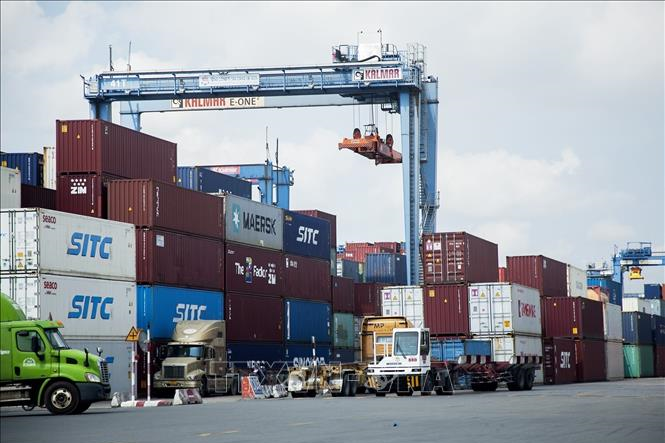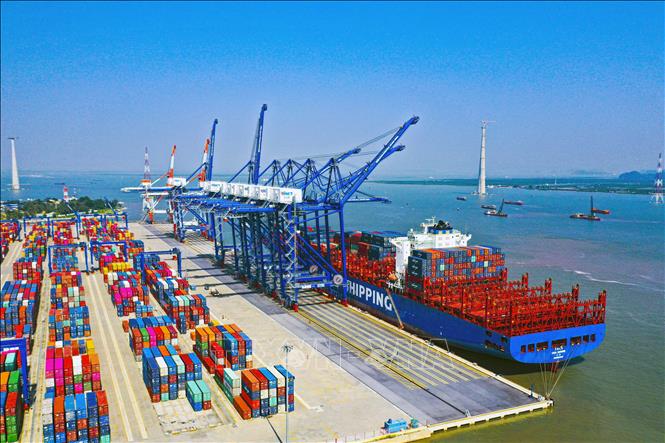
Green Logistics – A New Path Toward Sustainable Development
Green logistics is considered a key link in “greening” the supply chain to promote sustainable development.
Therefore, in the context of consumers preferring environmentally friendly products and the shift toward a green economy, green logistics is receiving increasing attention and professional investment. Seizing this trend, logistics enterprises are gradually participating in supporting production and domestic goods circulation as well as import and export with green criteria to aim for sustainable development.

Lach Huyen International Port, Hai Phong. Photo: Duc Nghia/VNA
Inevitable Trend
As a service sector playing an important role in connecting, supporting, and promoting socio-economic development, Vietnam’s logistics industry has maintained an average annual growth rate of 14-16%, with improved service quality, making a significant contribution to import–export activities as well as the domestic trade supply chain.
Notably, the Government has identified logistics as an important service industry within the overall structure of the national economy, serving as a driver for connectivity and socio-economic growth nationwide, and contributing to enhancing the economy’s competitiveness.
According to Mr. Tran Thanh Hai, Deputy Director of the Agency of Foreign Trade (Ministry of Industry and Trade), Vietnam’s logistics sector has many favorable conditions for development as numerous localities have formulated plans and strategies for this field.
In addition, investment in the logistics sector is growing rapidly, reflected in infrastructure projects such as expressways, the Long Thanh airport project, port expansions, and the construction of new logistics centers.
Moreover, as foreign enterprises recognize the high profitability of Vietnam’s logistics market, the speed and volume of capital inflows into the sector will increase significantly. Rising investment will also bring improvements in infrastructure and service operations, creating better development conditions.
However, 2023 will be a challenging year as the world faces recession and inflation, leading to a decline in trade activities, which in turn impacts logistics.
Furthermore, businesses must adapt to and embrace the trend of greening logistics. This means higher standards for goods, business operations, and increased costs.
Experts note that although logistics plays an important role in the production and trade chain, it is also one of the sectors that significantly pollute the environment, with freight transport accounting for about 8% of total global CO2 emissions. Therefore, developing green logistics is an inevitable trend and an important criterion for assessing the sector’s sustainable development.
According to the World Bank (WB), transport activities in Vietnam emit about 30 million tons of CO2 annually, with road transport accounting for 85% of these emissions. This figure is projected to grow by 6-7% annually. Moreover, Vietnam’s greenhouse gas emissions per GDP unit (1,090 g CO2/GDP) are rated much higher than many developed and developing countries worldwide.
For this reason, the purpose of green logistics is to optimize the relationship between warehouse operations, goods distribution, and the natural environment—meeting present needs without reducing the availability or quality of resources.
At the core of this trend is applying management and technical measures to reduce losses and energy consumption of vehicles and equipment, while still meeting production and life demands. Thus, green logistics is a goal pursued by many countries around the world.
Support for Enterprises

Cat Lai Port (Ho Chi Minh City) is one of the international transit gateways. Photo: Hong Dat/VNA
Experts warn that without meeting environmental and green logistics standards, businesses will eventually be eliminated from trade and business activities.
Currently, many enterprises have embraced the green logistics trend, spreading a meaningful environmental message and implementing sustainable development strategies.
For example, the Nam Hanoi Cold Storage is among the earliest cold storage service businesses to adopt green practices and has received the 3-star Hanoi Green Energy Award from the Hanoi People’s Committee.
Since its inception, Nam Hanoi Cold Storage has maintained its role as a central hub for frozen logistics, with an internationally certified cold storage system. It offers packaging services using biodegradable wrap made from the simplest materials that naturally decompose.
Additionally, the company regularly assesses activities that damage goods or cause inefficiencies during transport that directly affect environmental pollution. It controls all factors causing temperature fluctuations, cold loss, and food spoilage during storage.
Similarly, Tan Cang – Cat Lai in Ho Chi Minh City was the first port to receive the Green Port title from the APEC Port Services Network Council. Its green port practices include applying Industry 4.0 technologies, replacing diesel-powered lifting equipment with electric-powered ones (saving about USD 1.5–2 million in fuel annually).
It has also increased waterway transport capacity to carry up to 3,000 TEUs at once, replacing about 2,000 container trucks; and implemented electronic documentation, reducing truck waiting times at port gates from 13 minutes to only 6 minutes.
Another example is the “Mobile Post Office” model of Viettel Post, which has reduced intermediate steps, cut transport distances by 15%, and reduced the number of transit vehicles. In particular, Viettel Post has also installed solar panels at sorting and distribution centers to power lighting and air-conditioning systems.
Green logistics development is an inevitable trend and an important criterion for assessing the sustainability of the logistics sector. However, to green the logistics industry, Mr. Dao Trong Khoa, Standing Vice Chairman of the Vietnam Logistics Business Association (VLA), recommends that the Government direct relevant ministries and agencies to support the logistics sector with funding for technology development and digital transformation under the national logistics action program.
In the new context, it is essential to have the capability to manage international goods flows and compete effectively by deploying high-tech systems to better participate in global transport and forwarding platforms.
Regarding industry associations and businesses, Mr. Tran Thanh Hai suggests that in the future it is necessary to raise awareness and jointly build a green logistics ecosystem and sustainable supply chains in production, business, distribution, and goods circulation.
Authorities will assist enterprises in increasing autonomy over raw materials, focusing on enhancing the added value of export goods, and avoiding the export of raw, bulky, low-value products.
Furthermore, enterprises should collaborate to research and develop standardized training programs tailored to logistics job positions, design specialized courses, and update knowledge on green human resource management associated with logistics and green supply chain management.
